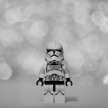
Lets talk about Uranus first
Uranus is the seventh planet from the Sun, and has the third-largest diameter in our solar system. It was the first planet found with the aid of a telescope, Uranus was discovered in 1781 by astronomer William Herschel, although he originally thought it was either a comet or a star.
It was two years later that the object was universally accepted as a new planet, in part because of observations by astronomer Johann Elert Bode. Herschel tried unsuccessfully to name his discovery Georgium Sidus after King George III. Instead, the scientific community accepted Bode's suggestion to name it Uranus, the Greek god of the sky, as suggested by Bode. - NASA
10 Need-to-Know Things About Uranus
1 . HUGE
Uranus is about four times wider than Earth. If Earth were a large apple, Uranus would be the size of a basketball.
2 . SEVENTH WANDERER
Uranus orbits our Sun, a star, and is the seventh planet from the Sun at a distance of about 1.8 billion miles (2.9 billion kilometers).
3 . SHORT-ISH DAY, LONGISH YEAR
Uranus takes about 17 hours to rotate once (a Uranian day), and about 84 Earth years to complete an orbit of the Sun (a Uranian year).
4 . ICE GIANT
Uranus is an ice giant. Most of its mass is a hot, dense fluid of "icy" materials – water, methane and ammonia – above a small rocky core.
5 . GASSY
Uranus has an atmosphere made mostly of molecular hydrogen and atomic helium, with a small amount of methane.
6 . MANY MOONS
Uranus has 27 known moons, and they are named after characters from the works of William Shakespeare and Alexander Pope.
7 . THE OTHER RINGED WORLD
Uranus has 13 known rings. The inner rings are narrow and dark and the outer rings are brightly colored.
8 . A BIT LONELY
Voyager 2 is the only spacecraft to fly by Uranus. No spacecraft has orbited this distant planet to study it at length and up close.
9 . LIFELESS
Uranus cannot support life as we know it.
10 . ONE COOL FACT
Like Venus, Uranus rotates east to west. But Uranus is unique in that it rotates on its side.
And if Uranus Collided With Earth?
The scenario described in this article is a fictional and highly unlikely event. In reality, the motion of celestial bodies in the solar system is governed by the laws of physics and gravity, and planets like Uranus do not spontaneously change their orbits or collide with other planets.
Uranus is indeed a distant ice giant in our solar system, located about 2.9 billion kilometers (1.8 billion miles) away from Earth on average. It has a stable orbit and is not on a collision course with Earth or any other planet.
Additionally, the description of Uranus as "smelling like farts" is a simplification and exaggeration. Uranus's atmosphere primarily consists of hydrogen, helium, and traces of methane. The presence of methane in its atmosphere is why it appears blue-green, as methane absorbs red light. The term "fart smell" is used humorously in popular science communication but is not an accurate representation of the planet's characteristics.
In summary, while the video presents an entertaining and imaginative scenario, it is not based on scientific reality. Uranus is not on a collision course with Earth, and such an event is not possible based on our current understanding of celestial mechanics and physics.






Comments (1)
Digiboy is not accepting comments at the moment
Want to show your support? Send them a one-off tip.